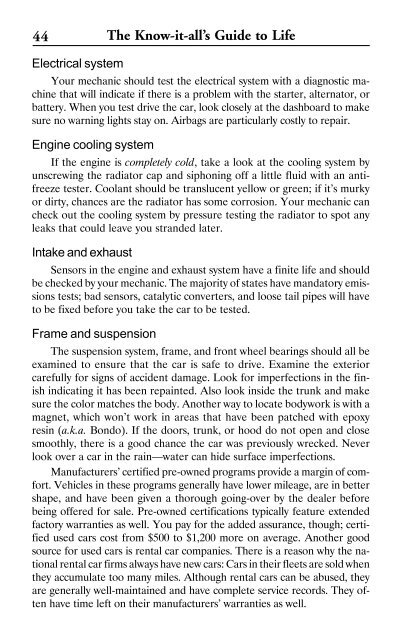How to get rid of tailgaters
How to get rid of tailgaters
How to get rid of tailgaters
Create successful ePaper yourself
Turn your PDF publications into a flip-book with our unique Google optimized e-Paper software.
44 The Know-it-all’s Guide <strong>to</strong> Life<br />
Electrical system<br />
Your mechanic should test the electrical system with a diagnostic machine<br />
that will indicate if there is a problem with the starter, alterna<strong>to</strong>r, or<br />
battery. When you test drive the car, look closely at the dashboard <strong>to</strong> make<br />
sure no warning lights stay on. Airbags are particularly costly <strong>to</strong> repair.<br />
Engine cooling system<br />
If the engine is completely cold, take a look at the cooling system by<br />
unscrewing the radia<strong>to</strong>r cap and siphoning <strong>of</strong>f a little fluid with an antifreeze<br />
tester. Coolant should be translucent yellow or green; if it’s murky<br />
or dirty, chances are the radia<strong>to</strong>r has some corrosion. Your mechanic can<br />
check out the cooling system by pressure testing the radia<strong>to</strong>r <strong>to</strong> spot any<br />
leaks that could leave you stranded later.<br />
Intake and exhaust<br />
Sensors in the engine and exhaust system have a finite life and should<br />
be checked by your mechanic. The majority <strong>of</strong> states have manda<strong>to</strong>ry emissions<br />
tests; bad sensors, catalytic converters, and loose tail pipes will have<br />
<strong>to</strong> be fixed before you take the car <strong>to</strong> be tested.<br />
Frame and suspension<br />
The suspension system, frame, and front wheel bearings should all be<br />
examined <strong>to</strong> ensure that the car is safe <strong>to</strong> drive. Examine the exterior<br />
carefully for signs <strong>of</strong> accident damage. Look for imperfections in the finish<br />
indicating it has been repainted. Also look inside the trunk and make<br />
sure the color matches the body. Another way <strong>to</strong> locate bodywork is with a<br />
magnet, which won’t work in areas that have been patched with epoxy<br />
resin (a.k.a. Bondo). If the doors, trunk, or hood do not open and close<br />
smoothly, there is a good chance the car was previously wrecked. Never<br />
look over a car in the rain—water can hide surface imperfections.<br />
Manufacturers’ certified pre-owned programs provide a margin <strong>of</strong> comfort.<br />
Vehicles in these programs generally have lower mileage, are in better<br />
shape, and have been given a thorough going-over by the dealer before<br />
being <strong>of</strong>fered for sale. Pre-owned certifications typically feature extended<br />
fac<strong>to</strong>ry warranties as well. You pay for the added assurance, though; certified<br />
used cars cost from $500 <strong>to</strong> $1,200 more on average. Another good<br />
source for used cars is rental car companies. There is a reason why the national<br />
rental car firms always have new cars: Cars in their fleets are sold when<br />
they accumulate <strong>to</strong>o many miles. Although rental cars can be abused, they<br />
are generally well-maintained and have complete service records. They <strong>of</strong>ten<br />
have time left on their manufacturers’ warranties as well.



